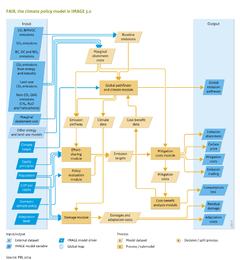Climate policy/Policy issues: Difference between revisions
Jump to navigation
Jump to search
No edit summary |
No edit summary |
||
| Line 22: | Line 22: | ||
As shown in Figure below, all reductions result from reduced emissions from deforestation (REDD). The contributions from {{abbrTemplate|REDD}} projects (about 560 MtCO2) are expected to exceed or match the required total reduction in all greenhouse gas emissions of 470 and 570 Mt CO2eq for the 36% and 39% reduction pledge scenarios. | As shown in Figure below, all reductions result from reduced emissions from deforestation (REDD). The contributions from {{abbrTemplate|REDD}} projects (about 560 MtCO2) are expected to exceed or match the required total reduction in all greenhouse gas emissions of 470 and 570 Mt CO2eq for the 36% and 39% reduction pledge scenarios. | ||
|Example= | |Example=The Global Pathfinder module was used to determine what the pledges for 2020 imply for global emission pathways consistent with meeting the 2 °C target ([[Van Vliet et al., 2012]]). The main findings were as follows (see also, Figure below): | ||
* The global 2020 emission level resulting from implementation of the Copenhagen Accord pledges exceeds those of least-cost pathways that achieve a 2 °C target; | |||
* Slightly postponing mitigation action (potential Copenhagen scenario) compared to the least-cost scenario seems technically feasible but at higher cumulative discounted mitigation costs; | |||
* For an even longer delay (the current Copenhagen scenario), the FAIR-SiMCaP model cannot fully compensate the higher emission level in the short term; | |||
* A delay in emission reductions limits the flexibility in the portfolio of emission reduction options. Such delayed scenarios rely more on the use of bioenergy with carbon capture and storage ({{abbrTemplate|BECCS}}), an option with uncertain prospects for large-scale implementation. | |||
}} | }} | ||
Revision as of 14:26, 15 May 2014
Parts of Climate policy/Policy issues
